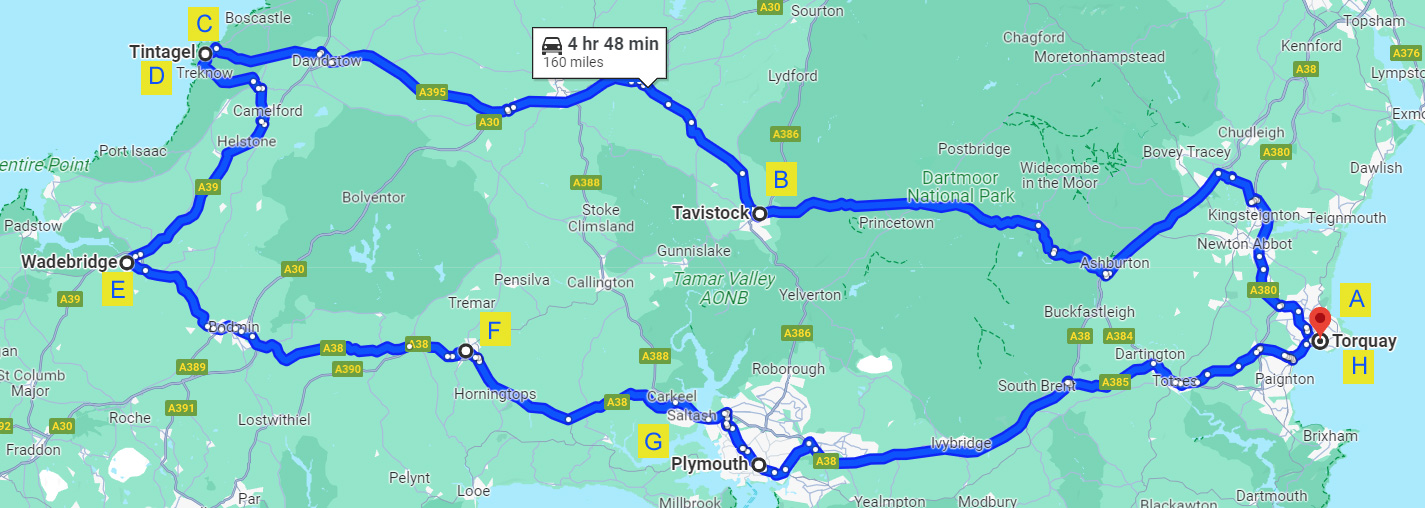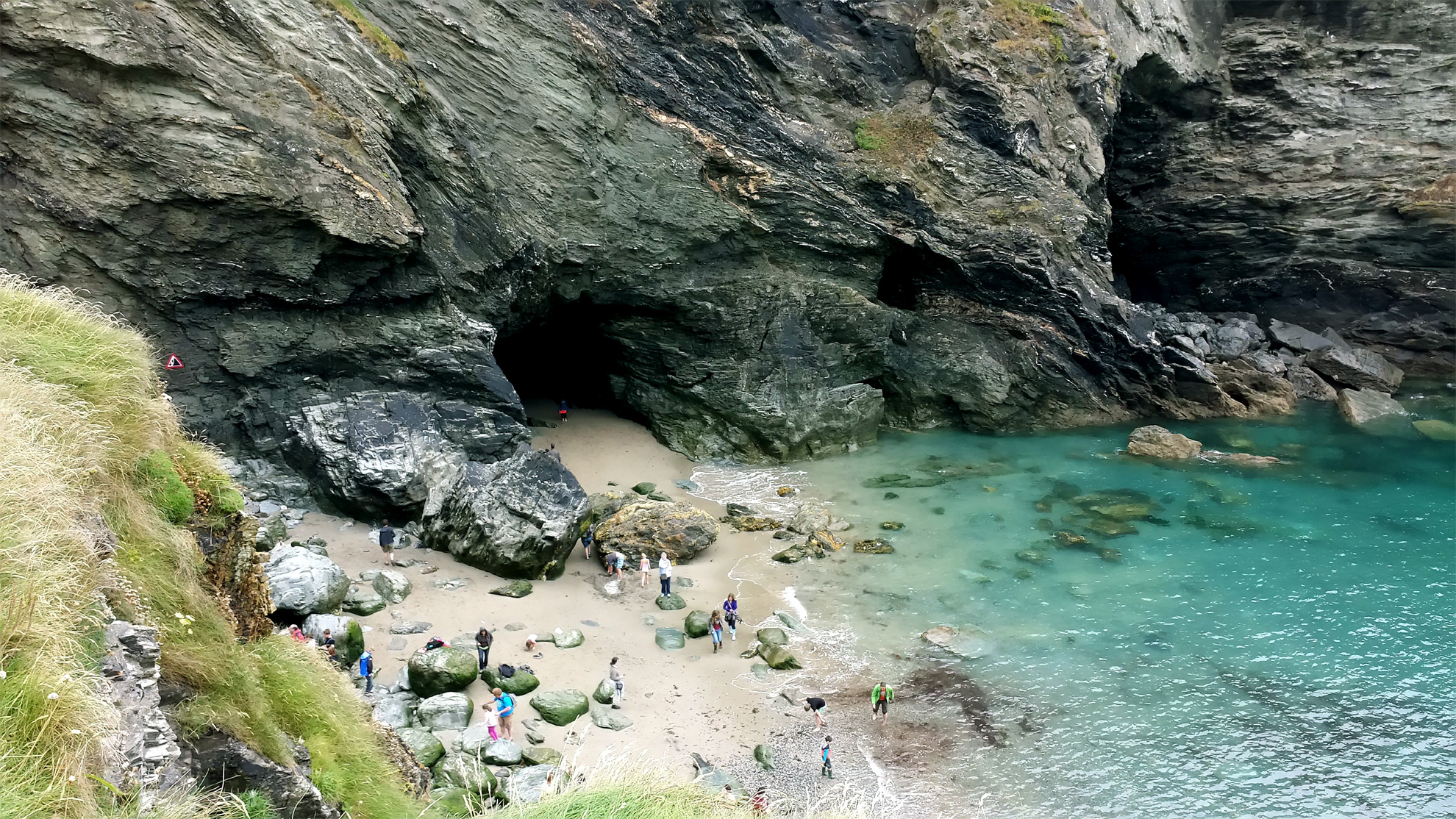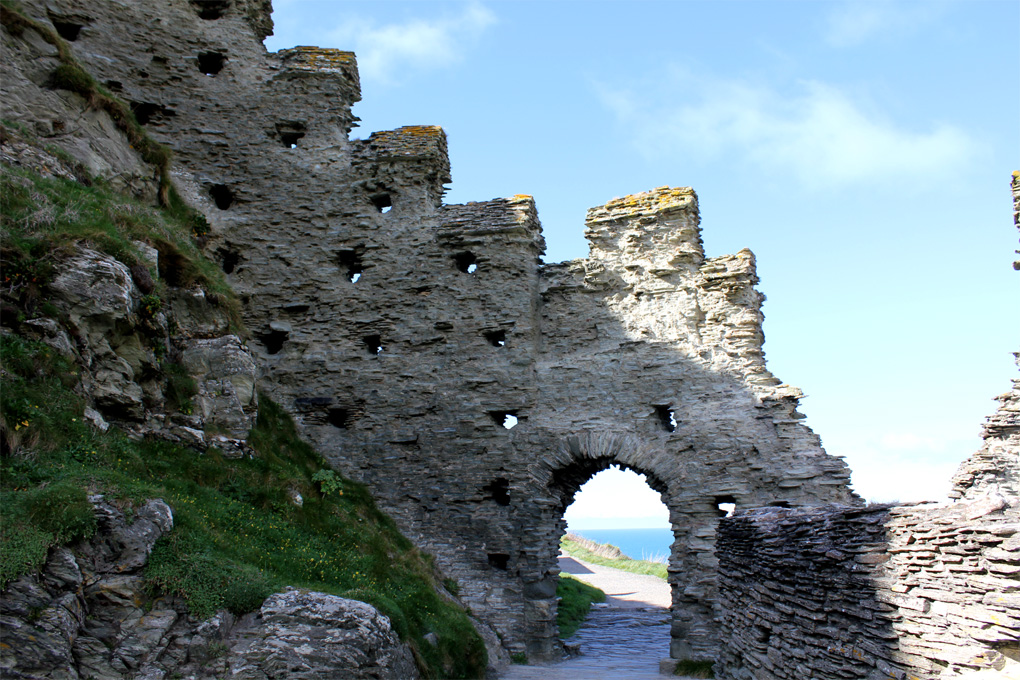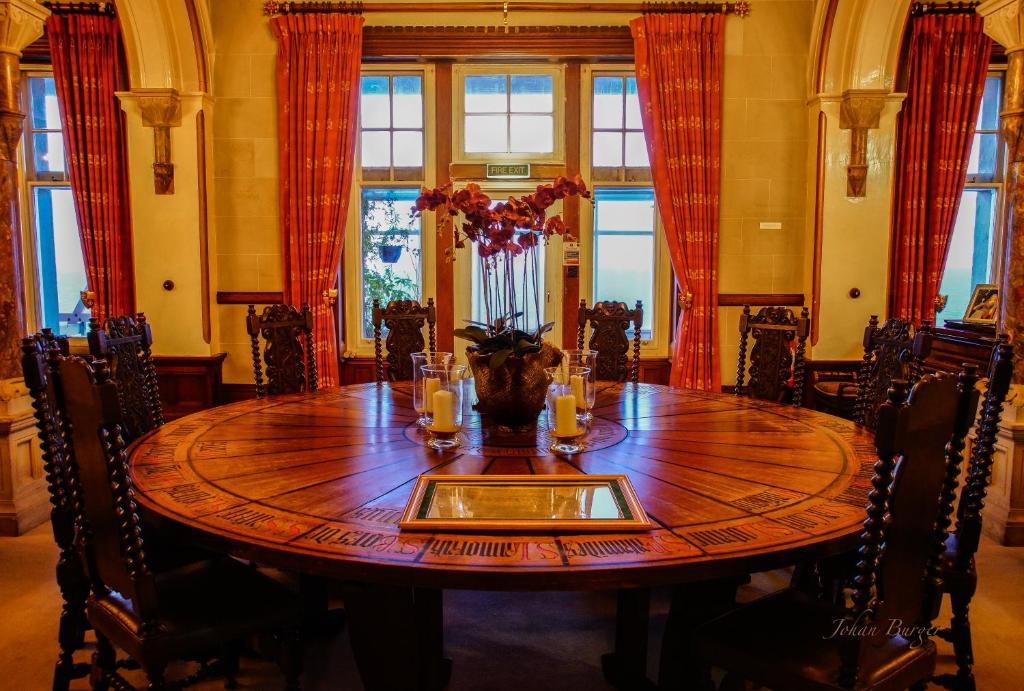On his final visit to Britain, Rudolf Steiner's schedule of lecturing was hectic. He delivered three lectures a day during the Anthroposophical Society's Summer School at Torquay (11-22 August 1924) - but that is another story.
Steiner took one day out of that busy schedule to be a tourist for a day. The decision took him as far west as he ever ventured in his lifetime - to the west cost of Cornwall.
Tintagel is the legendary home of King Arthur, Merlin, the sword Excalibur, the Lady of the Lake, the Knights of the Round Table, Sir Lancelot, Queen Guinevere, and the court of Camelot. Ashley (2010) dates the Arthurian period as between 400-600 AD but there is no extant documentation to distinguish between myth, legend, and veridical history.
Midway through the Torquay Summer School, on Sunday August 17th, Rudolf Steiner declared "I want to go to King Arthur" (Eleanor Merry, 1956, in Villeneuve, 2004, p.1051). A cavalcade of three cars ventured forth from the southern beachside resort town of Torquay, across the verdant moors of Dartmoor, to the spectacularly positioned Tintagel, on the west coast of Cornwall. The journey took them through the centre of Dartmoor to Tavistock, then across to Boscastle, and down to Tintagel (B, C & D in Figure 1). Although Villeneuve (2004, p.1052) states that it was a "50-mile journey", it is today a drive of 69 miles and of two and a quarter hours.

Eleanor Merry and D.N. Dunlop were the two organisers of the Torquay Summer School (Steiner, 1924b). Both were part of the entourage to Tintagel. Merry reports that: "At last we came again to the sea, and straight ahead of us, at the top of a green cliff, were the last fragments of King Arthur's castle of Tintagel. A deep rocky chasm divided this from a second rugged cliff, where still other remains could be seen" (quoted in Villeneuve, 2004, p.1052) (Plate 1).

Merry continues: "Dr.Steiner was at first silently absorbed in the wonderful view. All around was sunshine, and fleeting cloud-shadows and little hurrying rainbows – and a stormy and angry sea" (in Villeneuve, 2004, p.1052).
In a poem, Steiner related what he experienced at Tintagel as "eloquent castle ruins ... strength to mould the soul comes storming from the sea ... Striking the soul in force" (in Villeneuve, 2004, p. 1055) (Plate 2).


Daniel Dunlop recollected: "My impression of him ... near the site of King Arthur's Castle at Tintagel ... was that his consciousness was fully awake in the spiritual and physical worlds at the same time ... As we descended the cliff, we went into what is traditionally called Merlin's Cave. Inside it was a wonderful natural structure" (in Villeneuve, 2004, pp.1054-5) (Plate 1).
The entourage to Tintagel included Marna Pease who later became the first secretary of the Anthroposophical Agricultural Foundation of Great Britain which was founded in 1928 (Paull, 2011b).
The entourage included at least two of the 111 attendees of Steiner's Agriculture Course at Kobierzyce (then Koberwitz), namely Dr Elisabeth Vreede and Guenther Wachsmuth (Paull, 2011a). That course (7-16 June, 1924) laid the foundations for the development of biodynamic agriculture.

Wachsmuth remembered: "On that unforgettable day Rudolf Steiner went with us to the place on the rough rocky western coast of Cornwall, Tintagel, where the castle of King Arthur had once stood ... That strangely densified spiritual atmosphere we shall never forget, so intensely to be felt as Rudolf Steiner climbed the strange projecting cliff on the lonely coast of Cornwall where the last walls of the castle of King Arthur towered over the roaring sea ... He spoke there, standing on the cliff, about the experience of the Knights of King Arthur ... He spoke of the teachings of Merlin ... The immediacy of the spiritual vision in this place was so intense that, during his descriptions, the entire reality, the external life and action ... of King Arthur's knights, stood before us as actual experience" (Wachsmuth, 1989, pp.563-4).
Wachsmuth's recollection in Full
from 'The Life and Work of Rudolf Steiner.' on his visit to Tintagel and King Arthur's Castle
On an unforgettable day Rudolf Steiner went with us to the place on the Rocky western coast of Cornwall, Tintagel, where the castle of King Arthur had once stood, where he and the Knights of the Round Table carried on their battle for victory against evil and to rescue the impulse of esoteric Christianity and the current of the grail for a new Epoch. That strangely densified spiritual atmosphere we shall never forget, so intensely felt as Rudolf Steiner climbed the strange projecting cliff on the lonely Coast of Cornwall where the last walls of the castle of King Arthur towered over the Roaring sea. The unceasing struggle of the Sun forces against the clouds and fog rising from the sea surrounded the cliffs and the castle with an atmosphere of an eternal Elemental battle
He spoke their standing on the cliff, about the experiences of the Knights of King Arthur, who experience in this external struggle of the forces of light with the elements of the earth a reflection of their own inner battles, where in the realm of soul and spirit light and darkness battle for the mastery, of the I-force, the illuminated consciousness of Man, strives to achieve in ceaseless battle mastery over the clouds and fog of passions.
He spoke of the teaching of Merlin, which was there fostered, of the service to the spiritual sun practice by Arthur's circle and their knowledge of the cosmic deed of Christ.
As he then surveyed on the highest point of the cliff the remains of the walls of the ancient castle, which indicated the structure of the mystery place of King Arthur and it's external lines, the past became present to him in his spiritual vision, and he described to us in living pictures pointing with his hand to the various parts of the castle where the Hall of the Round Table had once been, the rooms of the king and his Knights. The immediacy of the spiritual vision in this place was so intense that, during his descriptions, the entire reality, the external life and action, the inner willing and achievement of the circle of King Arthur's knights, stood before us as actual experience.
That such an occurrence is in our time actually possible making the past livingly present through spiritual vision and the resulting real union of present experience and will with a spiritual stream of a past age, this fact gave to those hours on the cliff of Arthur's castle in Tintagel the sacred character of a deed which is inscribed in the annals of history.
Dr. Steiner's recollection of that day
as given during a lecture on 10 September 1924 in Dornach
During our recent stay in England ... at Torquay in the West of England, not far from the place [Tintagel, North Cornwall] where Arthur was with his followers once upon a time, a result of spiritual research was given to me, pointing to a belated working of this kind in a pre-Christian Christianity. For at this place it had indeed been preserved into a far later time.
The content of the King Arthur Legend referred to later times by a scholarship which is not at all scholarly in respect of the real facts, reaches back in reality into a very early epoch, and it is indeed a deep impression which one may receive when one stands at that place, looking down into the sea, even as once upon a time the Knights of the Round Table looked out upon the sea from there. Even today, if one is receptive to these things, one receives a very real impression which tells one what it was that the Knights of the Round Table of King Arthur did in their gigantic castle. The last relics of the castle, the crumbling stones, the latest witnesses to its existence, stand there to this day. Gigantic is the impression of this place of ruins, entirely broken down as it is, and from there one looks out into the ocean.
It is a mountainous promontory with the sea on either side. The weather changes almost hour by hour. We look out into the sea and watch the glittering sunshine reflected in the water. Then the next moment there is wind and tempest. Looking with occult vision at what takes place there to this day, we receive a magnificent impression. There live and weave the elemental spirits evolving out of the activities of the light and air, and of the foaming waves of the sea that turn and beat upon the shore. The life and movement and interplay of these elemental spirits gives even today a vivid and direct impression of how the sun works in its own nature in the earth, and meets with that which grows forth from the earth below by way of powers and spirits of the Elements.
There we receive even today the impression: such was the immediate original source of inspiration of the twelve who belonged to King Arthur. We see them standing there, these Knights of the Round Table, watching the play of the powers of light and air, water and earth, the elemental spirits. We see too how these elemental spirits were messengers to them, bringing to them the messages from sun and moon and stars which entered into the impulses of their work, especially in the more ancient time. And much of this was preserved through the centuries of the post-Christian time, even into the 9th century of which I was just speaking.
It was the task of the Order of King Arthur, founded in that region by the instructions of Merlin, to cultivate and civilise Europe at a time when all Europe in its spiritual life stood under the influence of the strangest elemental beings. More than will be believed today, the ancient life of Europe needs to be comprehended in this sense. We must see in it on all hands the working of elementary spiritual beings, right into the life of man.
The Arthurian life goes back into pre-Christian times, and before the Gospel came there, even in its oldest forms, there lived in it the knowledge, at any rate the practical instinctive knowledge of Christ as the Sun Spirit, before the Mystery of Golgotha. And in all that the Knights of the Round Table of King Arthur did, this same Cosmic Christ was living, the Christ who though not under the name of Christ, was also living in the impetus with which Alexander the Great had carried the Grecian culture and spiritual life into Asia. There were, so to speak, later 'campaigns of Alexander’ undertaken by the Knights of the Round Table of King Arthur into Europe, even as the real campaigns of Alexander had gone from Macedonia to Asia.
I mention this as an example, which could be investigated in the most recent times, to show how the worship of the sun, that is to say, the ancient worship of the Christ, was cultivated in such a place, though needless to say it was the Christ as He was for men before the Mystery of Golgotha. There all things were cosmic, even to the transition of the cosmos into the earthly Elements, the elemental spirits who lived in light and air and water and in the earth, for even in these there lived the cosmic forces. It was not possible at that time in the knowledge of these Elements to deny the cosmic principle that they contained. Thus even in the 9th century, in the paganism of Europe, there still lived much of the pre-Christian Christianity. That is the remarkable fact. Moreover even in that time the belated followers of European paganism understood the Cosmic Christ far more worthily and truly than those who received the Christ in the Christianity that was spread officially under that name. Strangely we can see the life around King Arthur radiate into the present time, continued even into our time, placed into the immediate present by the sudden power of destiny. Thus I beheld in seership a member of the Round Table of King Arthur, who lived the life of the Round Table in a very deep and intense way, though he stood a little aside from the others who were given more to the adventures of their knighthood. This was a knight who lived a rather contemplative life, though it was not like the Knighthood of the Grail, for this did not exist in Arthur's circle. What the knights did in the fulfilment of their tasks, which in accordance with that age were for the most part warlike campaigns, was called by the name 'Adventure’ (Aventure). But there was one who stood out from among the others as I saw him, revealing a life truly wonderful in its inspiration. For we must imagine the knights going out on to the spur of land, seeing the wonderful play of clouds above, the waves beneath, the surging interplay of the one and the other, which gives a mighty and majestic impression to this very day. In all this they saw the Spiritual and were inspired with it, and this gave them their strength. But there was one among them who penetrated most deeply into this surging and foaming of the waves, with the spiritual beings wildly rising in the foam with their figures grotesque to earthly sight. He had a wonderful perception of the way in which the marvellously pure sun-influence played into the rest of nature, living and weaving in the spiritual life and movement of the surface of the ocean. He saw what lived in the light nature of the sun, borne up as it were by the watery atmosphere as we can see to this day, the sunlight approaching the trees and the spaces between the trees quite differently than in other regions, glittering back from between the trees, and playing often as in rainbow colours. Such a knight there was among them, one who had a peculiarly penetrating vision of these things. I was much concerned to follow his life into later time to see the individuality again. For just in this case something would needs enter into a later incarnation of a Christian life that was almost primitive and pagan, that was Christian only to the extent that I have just described. And this in fact was what appeared, for that Knight of the Round Table of King Arthur was born again as Arnold Böcklin. This riddle which had followed me for an immensely long time, can only be solved in connection with the Round Table of King Arthur.
Mabel Cotterell relates that "Afterwards we all rested in the big hall of the castle hotel with its round table inscribed with the names of the knights" (in Villeneuve, 2004, p. 1055). The nearby hotel is now called 'Camelot' (Plate 3). It is situated spectacularly on the cliff-front of the promontory adjacent to the Tintagel Castle ruins. Villeneuve (p.1055) describes the hotel as "the monstrous Victorian pile of King Arthur's Castle Hotel, located in the dominant position on the neighbouring Fire Beacon Cliff". Albert Steffen, then editor of the periodical Anthroposophical Movement (Steiner, 1924a), reports Steiner's comment that "The only disturbance is from this hideous hotel, in which there even stands the ape of Arthur's Table" (in Villeneuve, 2004, p. 1055) (Plate 4).

The party's return journey bypassed Dartmoor entirely and took a route via Wadebridge, Liskeard, and Plymouth (E, F & G in Figure 1).
The Tintagel visit occurred just two months after Steiner's Agriculture Course and less than six weeks before Rudolf Steiner retreated from public life entirely. On this, his tenth visit to Britain, Steiner taught of Anthroposophy and Waldorf education. An opportunity for agriculture lectures in Britain did not arise, and there had been no Anglo attendees at the Koberwitz course. We can speculate that the attendance of Wachsmuth and Vreede, who had attended at Koberwitz - as well as Tintagel, in this case along with Marna Pease - may have seeded the early interest in Britain in Anthroposophic agriculture and which evolved into biodynamics agriculture.

Marna Pease went on to be the secretary of Britain's Anthroposophical Agricultural Foundation which was founded in 1928 (Paull, 2011b). Elizabeth Vreede attended, in London, as a guest at the first Annual Meeting of the Anthroposophical Agricultural Foundation (AAF, 1929). Pease subsequently translated several farming texts: Nine Lectures on Bees (Steiner, 1933), and The Moon and the Growth of Plants (Kolisko, 1936); and she authored the pamphlet A New Farming and Gardening: For Enquirers (1937). Despite the intensity with which Rudolf Steiner engaged with his missions, including the Torquay Summer School, he was, by this time terminally ill from being poisoned eight months earlier (Whitehead, 2010). Wachsmuth described this final visit to Britain: "During ... the last trip of Rudolf Steiner in his life on earth, he suffered tragically from the destructive illness. Outwardly, nothing of this could be observed. He met daily all the requirements of the comprehensive program and his lecturing activity. He spoke introductory words at artistic programs, had numerous conferences, and took part in the excursions, but every meal caused in his ill condition renewed suffering, which he bore courageously without a word of complaint ... He permitted nothing to be known by those at the conference regarding his illness" (Wachsmuth, 1989, p.563).
Just a month after this tenth visit to Britain, Rudolf Steiner retreated entirely from public life (on 28 September, 1924), and he died on 30 March 1925 (Collison, 1925).
References
AAF. (1929). Annual Meeting of the Anthroposophical Agricultural Foundation, Minutes: 3 pp. typescript.
Ashley, M. (2010). A Brief History of King Arthur. London: Constable & Robinson.
Collison, H. (1925). Rudolf Steiner. X a.m. 30th March, 1925, R.I.P. Anthroposophical Movement, 2(13), 101.
Kolisko, L. N. (1936). The Moon and the Growth of Plants (M. Pease, Trans.). London: Anthroposophical Agricultural Foundation.
Paull, J. (2011a). Attending the First Organic Agriculture Course: Rudolf Steiner's Agriculture Course at Koberwitz, 1924. European Journal of Social Sciences, 21(1), 64-70.
Paull, J. (2011b). Biodynamic Agriculture: The journey from Koberwitz to the World, 1924-1938. Journal of Organic Systems, 6(1), 27-41.
Pease, M. (1937). A New Farming and Gardening: For Enquirers (Leaflet No. 2, 2nd Series). Bray-on-Thames, Berkshire: Anthroposophical Agricultural Foundation.
Steiner, R. (1924a). On the conduct of this news-sheet, and the share members should take in it. Anthroposophical Society in Great Britain Monthly News-Sheet for Members, January, 8.
Steiner, R. (1924b). To all members: Our summer courses in Torquay. Anthroposophical Movement, 1(24 August), 81-83.
Steiner, R. (1933). Nine Lectures on Bees: Given in 1923 to the workmen at the Goetheanum (M. Pearse, Trans.). London: Anthroposophical Agricultural Foundation.
Villeneuve, C. (2004). Rudolf Steiner in Britain: A Documentation of his Ten Visits, Volume 11, 1922-1925. Forest Row, UK: Temple Lodge.
Wachsmuth, G. (1989). The Life and Work of Rudolf Steiner (O. D. Wannamaker & R. E. Raab, Trans. 2nd edition; first published in German 1941). Blauvert, NY: Spiritual Science Library.
Whitehead, A. (2010). Rudolf Steiner: Journey of a Grail Knight Warrior. Blackheath, NSW: Golden Beetle Books.

John Paull, PhD
University of Tasmania, Land and Food, Department Member
Dr John Paull is an environmental scientist with a keen interest in the metrics and development of organic food and agriculture, sustainable agriculture and related issues.
* I added a few photographs (without the 'plate' designation and replaced plate 3 & 4 with newer images), remade the map and added the two quote blocks (sourced from https://anthroposophy.eu/Arthur_stream). ~Anthony